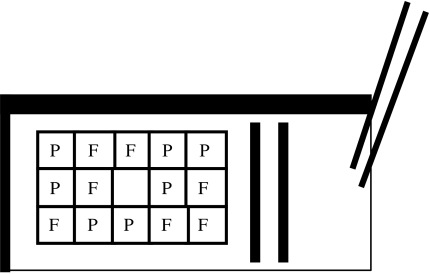Figure 1.
Experimental Plexiglas plate. The stripes on the plates that are illustrated in black had two different colouration patterns, either pink and black or yellow and beige. The initial preference test was conducted with one plate type, and the teaching trials and the final experiment with the other plate type. Fourteen food items were offered in each trial. Grid cells were filled from the upper left to the lower right, according to a random, but balanced, sequence from a random table. Once one food type had been selected seven times, the remaining grid cells were filled with the other food type. Each random sequence was used only once in each of the three treatment groups; the sequence shown in the figure is just one possibility. P, prawn item (corresponding to a 0 in the random sequence); F, flake item (corresponding to a 1 in the random sequence). On the right of the plate is the lever (40 cm long) that allowed the experimenter to react to cleaner fishes' foraging behaviour according to the treatment group (no reaction, fleeing, or chasing in response to prawn feeding).

